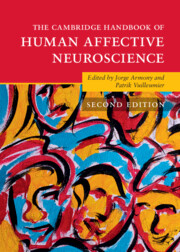Book contents
- The Cambridge Handbook of Human Affective Neuroscience
- Cambridge Handbooks in Psychology
- The Cambridge Handbook of Human Affective Neuroscience
- Copyright page
- Contents
- Figures
- Tables
- Contributors
- Introduction
- Section I Theoretical Models of Emotion
- Section II Measuring Emotional Processes
- Section III Emotion Perception and Elicitation
- Chapter 9 The Perception of Facial Expressions of Emotion
- Chapter 10 Body of Knowledge
- Chapter 11 A Lifespan Perspective of Emotion in Voice Perception
- Chapter 12 Pain in the Brain
- Chapter 13 Olfaction and Emotion
- Chapter 14 Music, Emotion, and Reward
- Chapter 15 Language and Emotion Concepts in the Predictive Brain
- Section IV Emotional Learning and Memory
- Section V Cognition–Emotion Interactions
- Section VI Social Emotions
- Section VII Individual Differences
- Index
- References
Chapter 15 - Language and Emotion Concepts in the Predictive Brain
from Section III - Emotion Perception and Elicitation
Published online by Cambridge University Press: 16 September 2025
- The Cambridge Handbook of Human Affective Neuroscience
- Cambridge Handbooks in Psychology
- The Cambridge Handbook of Human Affective Neuroscience
- Copyright page
- Contents
- Figures
- Tables
- Contributors
- Introduction
- Section I Theoretical Models of Emotion
- Section II Measuring Emotional Processes
- Section III Emotion Perception and Elicitation
- Chapter 9 The Perception of Facial Expressions of Emotion
- Chapter 10 Body of Knowledge
- Chapter 11 A Lifespan Perspective of Emotion in Voice Perception
- Chapter 12 Pain in the Brain
- Chapter 13 Olfaction and Emotion
- Chapter 14 Music, Emotion, and Reward
- Chapter 15 Language and Emotion Concepts in the Predictive Brain
- Section IV Emotional Learning and Memory
- Section V Cognition–Emotion Interactions
- Section VI Social Emotions
- Section VII Individual Differences
- Index
- References
Summary
There is growing evidence that language plays an important role in emotion because it helps people acquire emotion concept knowledge. In this chapter, we argue that language plays a mechanistic role in emotion because emotion concept knowledge, once acquired, is used by the brain to predictively and adaptively regulate a person’s subjective emotional experiences and behaviors. Building on predictive processing models of brain function, we argue that the emotion concepts learned via language during early development “seed” the brain’s emotional predictions throughout the lifespan. We review constructionist theories of emotion and their support in behavioral, physiological, neuroimaging, and lesion data. We then situate these constructionist predictions within recent neuroscience research to speculate on the neural mechanisms by which emotion concepts “seed” emotional experiences.
Information
- Type
- Chapter
- Information
- The Cambridge Handbook of Human Affective Neuroscience , pp. 306 - 322Publisher: Cambridge University PressPrint publication year: 2025
References
Accessibility standard: WCAG 2.0 A
Why this information is here
This section outlines the accessibility features of this content - including support for screen readers, full keyboard navigation and high-contrast display options. This may not be relevant for you.Accessibility Information
Content Navigation
Allows you to navigate directly to chapters, sections, or non‐text items through a linked table of contents, reducing the need for extensive scrolling.
Provides an interactive index, letting you go straight to where a term or subject appears in the text without manual searching.
Reading Order & Textual Equivalents
You will encounter all content (including footnotes, captions, etc.) in a clear, sequential flow, making it easier to follow with assistive tools like screen readers.
You get concise descriptions (for images, charts, or media clips), ensuring you do not miss crucial information when visual or audio elements are not accessible.
You get more than just short alt text: you have comprehensive text equivalents, transcripts, captions, or audio descriptions for substantial non‐text content, which is especially helpful for complex visuals or multimedia.
Visual Accessibility
You benefit from high‐contrast text, which improves legibility if you have low vision or if you are reading in less‐than‐ideal lighting conditions.
Structural and Technical Features
You gain clarity from ARIA (Accessible Rich Internet Applications) roles and attributes, as they help assistive technologies interpret how each part of the content functions.
